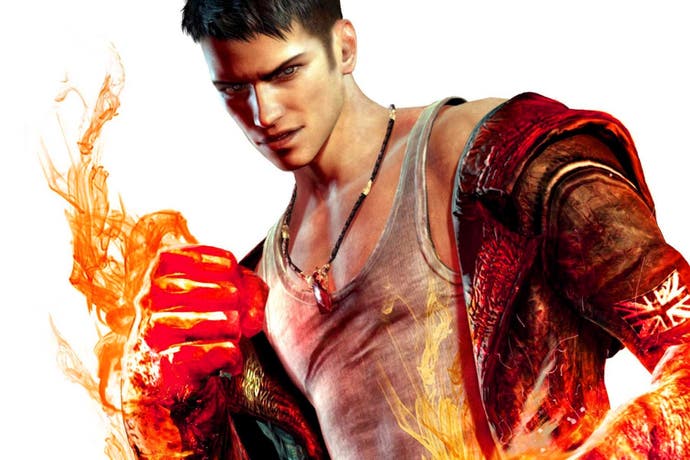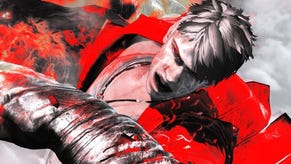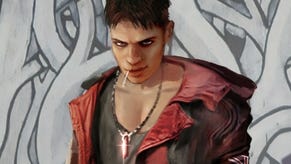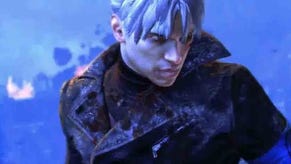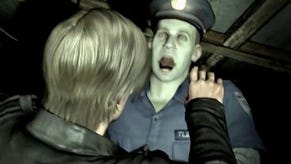Face-Off: DmC Devil May Cry
Hue and cry.
| - | Xbox 360 | PlayStation 3 |
|---|---|---|
| Disc Size | 6.7GB | 6.75GB |
| Install | 6.7GB (optional) | 2458MB (mandatory) |
| Surround Support | Dolby Digital | Dolby Digital, DTS, 5.1LPCM |
The first Face-Off of 2013 is based on a title that has divided its fanbase since its initial reveal at the 2010 Tokyo Game Show; Capcom's reboot of the Devil May Cry series, DmC, features a dramatic change in Dante's appearance, with the character ditching his iconic flash of white hair in favour of a darker emo-styled look, while taking on an even more blasé attitude. Perhaps more controversial than the rebooted storyline is the fact that Capcom enlists UK developer Ninja Theory for the new game, choosing a 30 frames-per-second update over the smooth 60FPS presentation of past titles. Series die-hards are concerned that the shift in developer combined with the decimated frame-rate will conspire to dilute the fast-paced action the series is known for in favour of something more palatable to mainstream tastes. Thankfully, this isn't the case, with Ninja Theory blending enjoyable melee and gun-based combat with an entertaining narrative and some stunning graphics.
Most importantly, at its heart DmC still feels like a Devil May Cry game. The drop to 30FPS allows for a colossal leap in graphical quality over its predecessor: dynamic environments are combined with highly detailed human characters and demonic enemies that appear realistically organic and at times quite beautiful. The way these elements interact with the player creates a considerably more immersive world that simply wouldn't be possible if the game ran at double the frame-rate.
For the most part, Ninja Theory's gorgeous design work and impressive technical prowess come across intact on both consoles, despite there being some clear differences between the two versions of the game. Each system has its own advantages and compromises, with the PS3 favouring texture detail and general image quality while higher-quality visual effects in combination with more stable performance are present on Xbox 360.
But how much of an impact does this have on the overall quality of the experience? Let's kick off with our head-to-head video and a huge comparison gallery boasting over 60 in-game shots.
"DmC halves the series' standard 60FPS gameplay in favour of more rendering time for some beautiful visuals."
Similar to most titles that use the Unreal Engine 3 middleware, DmC runs at native 720p on both platforms, working in combination with a post-process edge-smoothing solution; on Xbox 360 it's pretty safe to say that FXAA is at work, with the trademark MSAA-type patterns visible around various edges. Thankfully, the artwork is well preserved compared to other games which use similar anti-aliasing solutions: texture blur is relatively minimal and the level of detail found throughout the game is very impressive, though DmC still features a somewhat soft look overall, the extent of which varies from scene to scene.
Things aren't so clear cut with the PS3 version: again, post-process anti-aliasing is used, but the algorithm in play here tends to catch fewer edges than the 360 game. However, coverage in these areas is visibly better, with geometry edges appearing both cleaner and clearer, benefiting the general look of the game. Despite the differing AA implementations, both versions see their fair share of jaggies, typically in detailed environments featuring structures defined by small complex geometry. In places where bigger and bulkier architecture is heavily used, things appear relatively clean and smooth with the AA working well to suppress unwanted artifacts.
It's not that often where we see the PS3 benefit from having higher-quality assets in multi-platform releases, but that's exactly what we find here in DmC - unless what we're seeing on 360 is the result of FXAA blurring. On many surfaces more clearly defined textures help to bring out more depth and detail to the scene - from the walls of the classically styled buildings to the engraving on Dante's pistols. However, when it comes down to the steaming of assets the PS3 version lags behind the 360, with some unexpected results. In some scenes we find the engine switching between low and high resolution textures as objects move closer to the camera, even if high-quality artwork is already present when the scene begins.
In that respect the use of the mandatory hard-drive install on the PS3 doesn't seemed to have helped much - and looking at how the other graphical elements of the game hold up in comparison to the 360 game, it appears that Ninja Theory has made a number of minor trade-offs in other areas. Most notably shadows are rendered in a lower resolution on the PS3, using low-cost hardware-based PCF (percentage closer filtering), leading to noticeable jaggedness and posterisation being visible - particularly during the cut-scenes, where the effects are hard to ignore.
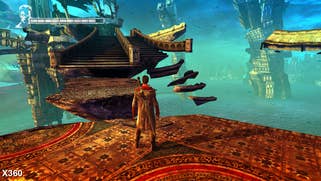
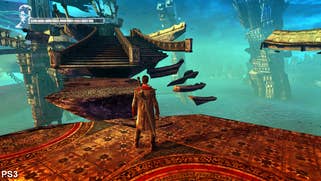


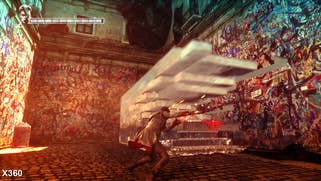

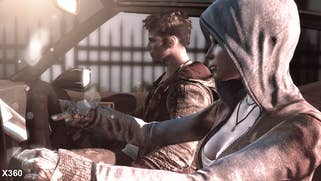
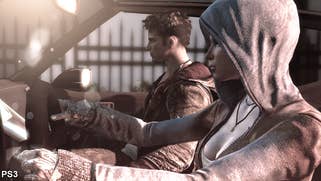
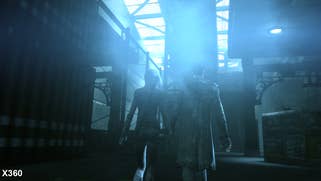
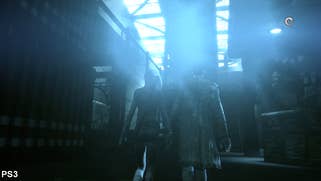
DmC uses an impressive object blur effect during both gameplay and real-time cut-scenes - one that is not too dissimilar to that found in Namco's Tekken Tag Tournament 2. The effect is designed to make combat scenes appear visually more brutal while helping to create a smoother-looking game. The amount of blur is applied more liberally on the 360 with more moves and characters being distorted when moving at high speed. It's also rendered using more samples to blend the effect, giving it a cleaner, less grainy look compared to the PS3 game.
Beyond this there are differences with the lighting model on both platforms, with various light sources being set in different places in some locations. At times this can dramatically change the look of the scene highlighting certain details left in the shade on one version over the other, but for the most part the effects are more subtle and are more visible in the cut-scenes than gameplay - neither version really benefits here. Additionally, an offset bias makes shadows protrude more outwardly on the PS3, while a slightly darker gamma set-up is also present on the console.
Away from graphical concerns, loading times are also longer on the PS3, despite the large mandatory install to the console's hard drive. New chapters usually take between five and 15 seconds to load on the 360 (installed), compared to 18 and 26 seconds on the PS3. During the loading screen a video is played of Dante executing a stylish combo. Usually on the 360 loading is mostly completed in a few seconds before Dante finishes his sequence, whereas on PS3 we often have to sit through it several times. The PS3 game also pauses to load in more data during the beginning of some cut-scenes, which can be quite jarring. At first we thought that the game might have crashed, but the little loading symbol in the corner of the screen proved otherwise.
DmC Devil May Cry: performance analysis
DmC targets a 30FPS update, with the developers using the doubling of render time per frame to produce far more complex visuals than its 60Hz forebears. Initial reactions from the series' core fanbase were decidedly negative with the move in this direction, with players complaining that this new game might lack the tight, highly precise combat of previous entries in favour of dumbed down mechanics. Ninja Theory addressed these concerns, stating that while the graphics engine does indeed run at 30FPS, the underlying gameplay mechanics would operate at 60FPS and as a result allow for more responsive controls than the standard 30FPS experience. Indeed, when compared to the developer's past titles - Heavenly Sword and Enslaved - this is certainly true: button presses result in moves being executed more quickly, and the core feel of past Devil May Cry titles remains well preserved in this new game.
As you would expect from the cut-down frame-rate, the combat in DmC doesn't feel as crisp and fluid as found in titles running twice as smoothly. While the gameplay mechanics may well operate at 60FPS, the amount of visual cues available to the player is still limited by the lower frame-rate (only one unique frame is rendered for every two displayed) and this leads to an increase in controller latency compared to games running at full-fat 60FPS.
The responsive feeling of the controls is also heavily reliant on the game maintaining a steady frame-rate. Any sudden or prolonged drops have a negative effect on the gameplay where executing long combos and stringing together moves while traversing the environment is concerned. In this respect we see a clear difference between the two versions of DmC, with the 360 claiming an advantage, especially when the player is engaged in heavy combat against multiple foes.
"Gameplay performance analysis highlights the improved consistency in the Xbox 360 version - frame-rates are smoother and there are no screen-tear issues."
For the most part, during less intense combat and general traversal scenes the PS3 version of DmC stays close to adopting a locked 30FPS, with very few instances where the frame-rate is allowed to drop. Occasionally, we might see a handful of torn frames on the PS3 - the 360 doesn't tear at all - along with some very minor dips in smoothness, but nothing that remotely distracts us from enjoying the fast and furious action Ninja Theory delivers. What is particularly impressive is that regardless of how intense and chaotic things may become, the 360 game remains solidly at 30FPS, maintaining a consistent controller response throughout.
In more demanding scenes the PS3 begins to struggle with the demands being placed on it by the engine. In comparison to the 360 game, a variety of large enemies on-screen along with huge boss characters cause the frame-rate to become quite inconsistent, and some heavy screen-tearing is also thrown into the mix. A combination of increased alpha-based effects, more detailed scenery, dynamic lighting, and a larger number of characters on-screen are the main causes here.
Outside of these areas the drop in performance isn't too severe, with the loss in smoothness lasting mostly for a second or so. However, these subtle dips can be felt in the controls while chaining together combos and quickly executing other moves during battle. There's a sense that the same level of consistently isn't there in every area of the game: one scene might play out perfectly with no ill effects while the next might be interrupted by the controls briefly feeling a bit more sluggish. Thankfully, outside of the bigger boss battle and elaborate traversal sequences - where the scenery is collapsing around Dante - the PS3 game manages to keep up with the 360.
"Cut-scenes see the implementation of v-sync on both platforms, resulting in fluctuating performance."
Like-for-like scenes are more revealing. Here the engine is mostly v-synced on both platforms, and this causes the GPU to stall more frequently on the PS3 when the rendering load increases, resulting in lower sustained frame-rates and visible judder. This makes the use of real-time cinematics even more jarring when mixed in with the far smoother FMV sequences. In effect, the frame-rate on the PS3 is far more erratic than the 360 game: in many clips we see what amounts to a locked 20FPS on Sony's system, creating a jerky-looking update that distracts from the well-directed scenes, while in others overall performance bounces up and down as the engine struggles to keep up with the demands being placed on it - the effect being somewhat similar to the later entries in the Mass Effect series.
That said, the 360 game isn't completely free from criticism. Occasionally, frame-rates drop into the mid-twenties in a few scenes, and sometimes lower - due to the strong use of v-sync, cut-scenes in general aren't quite so solidly locked to 30FPS as the gameplay. However, the engine does recover far more quickly than the PS3 game, and the fluctuations in frame-rate certainly aren't commonplace. On the other hand, tearing is a complete non-issue for both systems in these sequences: we see the odd torn frame on appear on the graphs in our video, but these are otherwise impossible to spot by eye.
In addition to featuring real-time cinematics, DmC also features a range of FMV cut-scenes which are rendered using in-game assets presumably using the Unreal Engine editor before being encoded into compressed video. These sequences run at 30FPS, but a permanent camera blur effect is used which makes the frame-rate appear much higher than it actually is - to the casual observer it can actually look like these parts of the game are running at 60FPS. The downside of using this extra blur to create a smoother presentation is that motion appears permanently smeared (akin to a 2007-vintage LCD panel) and fine detail is hidden under a veil of heavy compression artifacts.
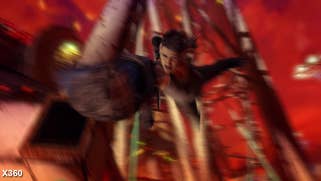

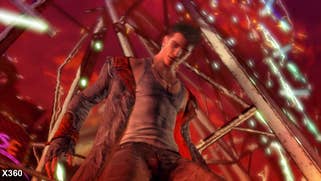
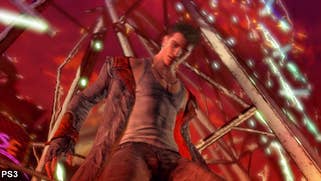
DmC Devil May Cry - the Digital Foundry verdict
While the change in developer and use of the Unreal Engine 3 might be cause for concern for those expecting a watered-down take on Capcom's Devil May Cry series, we needn't have worried so much. Ninja Theory comfortably balances the need for theatrics and spectacle with traditional fast-paced melee combat and gunplay. The switch to 30FPS also works well in making the world a more captivating place to stage the elaborate boss battles and chaotic action sequences; at times the visuals are truly stunning to behold.
As ever with multi-format Unreal Engine 3 titles, there are compromises between platforms, with the 360 version coming across as the more polished of the two offerings. While the inclusion of higher-resolution artwork on the PS3 is a nice touch, the lower-quality shadows and less consistent performance are more noticeable to the eye during play. In particular, subtle dips in smoothness have more of a tangible effect on gameplay than they do in titles running twice the frame-rate. The crisp controls become temporarily compromised in hectic scenes, delivering an experience which doesn't feel as consistent or enjoyable. On the plus side, the PS3 version has plenty of moments where it maintains a solid 30FPS - even in some of the more taxing scenarios early on it the game - so is still well worth getting regardless of the deficiencies elsewhere. However, on balance, the 360 version edges it thanks to the more consistent performance and palpable lack of screen-tear.
Overall, it's pleasantly surprising to see DmC working as well as it does at 30 frames per second, proving that high-speed action titles don't necessarily demand a 60Hz lock. That said, we're particularly looking forward to playing the upcoming PC version, where players can hopefully enjoy all the sumptuous visuals of the console versions at much higher resolutions, with the 60FPS response fully restored - something that hardcore fans will almost certainly appreciate.
